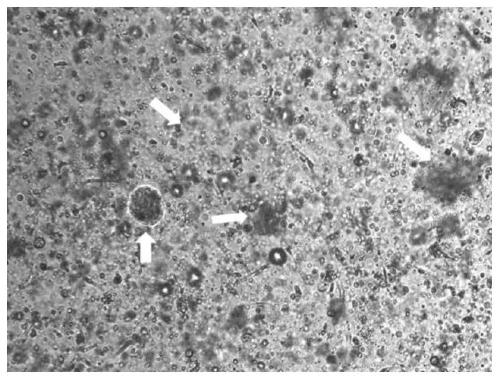Breast cancer organoid culture kit
An organoid, breast cancer technology, applied in cell culture active agent, culture process, tissue culture, etc., can solve the problems of error, contamination, preparation, complicated operation steps, etc.
- Summary
- Abstract
- Description
- Claims
- Application Information
AI Technical Summary
Problems solved by technology
Method used
Image
Examples
Embodiment 1
[0029] 1. Preparation of the kit
[0030] Preparation of DMEM / F12 medium: DMEM medium is a medium containing amino acids and glucose with high nutrient concentration, while F12 medium has complex components and contains a variety of trace elements. For DMEM / F12 medium. Suitable for the organoid culture of the present invention.
[0031] Preparation of sample preservation solution: take 1000ml of DMEM / F12 medium combined at 1:1, add 0.5ml of prepared penicillin solution (take 800,000 U / bottle of penicillin, dissolve in 4ml of sterile distilled water) to make the final concentration is 100U / ml; add 0.5ml of prepared streptomycin solution (take 1g / bottle of streptomycin and dissolve it in 5ml sterile distilled water) to make the final concentration 0.1mg / ml; add prepared L-Valley 10ml of aminoamide solution (2.922g of L-glutamine was dissolved in three distilled water and added to 100ml to make a solution of 200mmol / L, fully stirred to dissolve, sterilized by filtration, divide...
Embodiment 2
[0046] Example 2: Culture of Breast Cancer Organoids
[0047] 1. Sample acquisition: use an automatic biopsy puncture gun, 18-16G biopsy puncture needle, and the sample length is 15-22 mm. Under the guidance of ultrasound, when reaching the edge of the lesion, start the puncture gun, and quickly pull out the needle after the sample is drawn. For 4-needle samples, the taken tissue is immediately put into the sample preservation solution, stored at 4 degrees, and the container is sealed and transported to the laboratory for further processing within 2 hours.
[0048] 2. Mince the sample to a diameter of 0.5-1 mm in a biological safety cabinet, put it into a centrifuge tube, add 10 ml of the organoid medium A, centrifuge for 10 minutes, and discard the supernatant;
[0049] 3. Add 10 ml of organoid culture medium A and collagenase at a concentration of 2 mg / ml, digest with a shaker at 37 degrees for 2 hours, wash the digested single cells, and count the cells.
[0050] 4. Centri...
Embodiment 3
[0052] Example 3: Passaging of Breast Cancer Organoids
[0053] 1. In a cell culture dish, add 2ml of trypsin to each well, keep it at room temperature for 5 minutes, then pipette with a glass pipette to disperse the cells to form single cells, and transfer them into a centrifuge tube;
[0054] 2. Add 10ml of organoid medium A to the centrifuge tube, centrifuge for 10 minutes, discard the supernatant, count the cells, add 120-240 μl BME, and adjust the cell concentration to 2x10 6 / ml, inoculated in a 24-well plate, 30-60 microliters per well, 200-800 microliters of organoid medium B was added to each well after 20 minutes, and placed in a 37-degree, 5% CO2 cell incubator,
[0055] 3. Change the medium every 3 to 5 days, add 200 to 800 microliters of organoid medium B for each change, and observe it under a microscope. Usually, the passaged breast cancer organoid tissue can be obtained in about 4 weeks. for further research.
PUM
 Login to View More
Login to View More Abstract
Description
Claims
Application Information
 Login to View More
Login to View More - R&D
- Intellectual Property
- Life Sciences
- Materials
- Tech Scout
- Unparalleled Data Quality
- Higher Quality Content
- 60% Fewer Hallucinations
Browse by: Latest US Patents, China's latest patents, Technical Efficacy Thesaurus, Application Domain, Technology Topic, Popular Technical Reports.
© 2025 PatSnap. All rights reserved.Legal|Privacy policy|Modern Slavery Act Transparency Statement|Sitemap|About US| Contact US: help@patsnap.com



